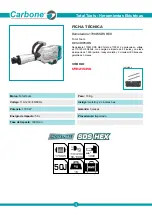
ENGLISH
en
8
On our own responsibility, we hereby declare that
this drilling and chisel hammer, identified by type
and serial number *1), meets all relevant
requirements of directives *2) and standards *3).
Technical documents for *4) - see page 3.
For UK only:
We as manufacturer and authorized person to
compile the technical file, see *4) on page 3,
hereby declare under sole responsibility that these
drilling and chisel hammer, identified by type and
serial number *1) on page 3, fulfill all relevant
provisions of following UK Regulations S.I. 2016/
1091, S.I. 2008/1597, S.I. 2012/3032 and
Designated Standards EN 62841:2015, EN IEC
62841-2-6:2020+A11:2020, EN IEC 63000:2018.
For your own protection and for the
protection of your power tool, pay
attention to all parts of the text that are
marked with this symbol!
WARNING
– Read the operating
instructions to reduce the risk of injury.
WARNING – Read all safety warnings,
instructions, illustrations and
specifications provided with this power tool.
Failure to follow all instructions listed below may
result in electric shock, fire and/or serious injury.
Save all warnings and instructions for future
reference.
Always include these documents when
passing on your power tool.
3.1 Safety instructions for all operations
a) Wear ear protectors.
Exposure to noise can
cause hearing loss.
b) Use auxiliary handle(s), if supplied with the
tool.
Loss of control can cause personal injury.
c) Hold the power tool by insulated gripping
surfaces, when performing an operation where
the cutting accessory or fasteners may contact
hidden wiring or its own cord.
Cutting accessory
contacting a "live" wire may make exposed metal
parts of the power tool "live" and could give the
operator an electric shock.
3.2 Safety instructions when using long drill
bits with rotary hammers
a) Always start drilling at low speed and with
the bit tip in contact with the workpiece.
At
higher speeds, the bit is likely to bend if allowed to
rotate freely without contacting the workpiece,
resulting in personal injury.
b) Apply pressure only in direct line with the bit
and do not apply excessive pressure.
Bits can
bend, causing breakage or loss of control, resulting
in personal injury.
3.3 Further Safety instructions
Always work with the additional handle correctly
installed.
Always hold the machine with both hands at the
intended handles, take a secure stance and
concentrate on the work.
Wear personal protective equipment and
always wear safety glasses.
Protective
equipment such as dust mask, non-skid safety
shoes, protective gloves, hard hat, or hearing
protection used for appropriate conditions will
reduce personal injuries.
Ensure that the spot where you wish to work is free
of
power cables, gas lines or water pipes
(e.g.
using a metal detector).
If the safety coupling responds, switch off the
machine immediately.
Do not touch the rotating tool!
Secure the workpiece to prevent slipping or rotation
(e.g. by securing with screw clamps).
Remove chips and similar material only with the
machine at a standstill.
Caution must be exercised when driving screws into
hard materials (driving screws with metric or
imperial threads into steel)! The screw head may
break or a high reverse torque may build up on the
handle.
Pull the plug out of the socket before making any
adjustments, changing tools, carrying out
maintenance or cleaning.
Avoid inadvertent starts by always unlocking the
switch when the plug is removed from the mains
socket or whenever the power fails.
A damaged or cracked additional handle must be
replaced. Never operate a machine with a defective
additional handle.
Metabo S-automatic safety clutch.
When the safety clutch responds, switch off the
machine immediately! If the tool jams or catches,
the power supply to the motor is restricted. Due to
the strong force which can arise, always hold the
machine with both hands using the handles
provided, stand securely and concentrate.
Reducing dust exposure:
WARNING
- Some dust created by power
sanding, sawing, grinding, drilling, and other
construction activities contains chemicals known to
cause cancer, birth defects or other reproductive
harm. Some examples of these chemicals are:
- Lead from lead-based paints,
- crystalline silica from bricks and cement and other
masonry products, and
- arsenic and chromium from chemically treated
lumber.
Original instructions
1. Declaration of Conformity
2. Specified Conditions of Use
3. Special Safety Instructions

























